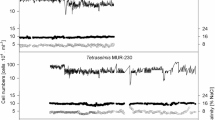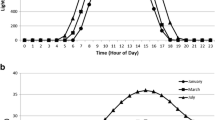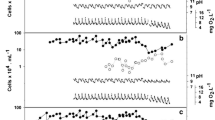Abstract
Semi-continuous algal cultivation was completed in outdoor flat-panel photobioreactors (panels) and open raceway ponds (raceways) from February 17 to May 7, 2015 for side-by-side comparison of areal productivities at the Arizona Center for Algae Technology and Innovation in Mesa, AZ, USA. Experiments used two strains of Scenedesmus acutus (strains LB 0414 and LB 0424) to assess productivity, areal density, nutrient removal, and harvest volume across cultivation systems and algal strains. Panels showed an average biomass productivity of 19.0 ± 0.6 g m−2 day−1 compared to 6.62 ± 2.3 g m−2 day−1 for raceways. Photosynthetic efficiency ranged between 1.32 and 2.24 % for panels and between 0.30 and 0.68 % for raceways. Panels showed an average nitrogen consumption rate of 38.4 ± 8.6 mg N L−1 day−1. Cultivation in raceways showed a consumption rate of 3.8 ± 2.5 and 7.1 ± 4.2 mg N L−1 day−1 for February/March and April/May, respectively, due to increase in biomass productivity. Excess nutrients were required to prevent a decrease in productivity. Daily biomass harvest volumes between 18 and 36 % from panels did not affect culture productivity, but density decreased with increased harvest volume. High cultivation temperatures above 30 °C caused strain LB 0414 to lyse and crash. Strain LB 0424 did not show any difference in biomass productivity when peak temperatures reached 34, 38, or 42 °C, but showed decreased productivity when the peak temperature during cultivation was 30 °C. Using algal strains with different temperature tolerances can generate increased annual biomass productivity.





Similar content being viewed by others
References
Borowitzka MA (1999) Commercial production of microalgae: ponds, tanks, tubes and fermenters. J Biotechnol 70:313–321
Buchanan AN, Bolton N, Moheimani N, Svoboda IF, Grant T, Batten D, Cheng NN, Borowitzka MA, Fallowfield HJ (2013) Algae for energy and feed: a wastewater solution. A Review. Pork CRC, Canberra, p 203
Chiaramonti D, Prussi M, Casini D, Tredici MR, Rodolfi L, Bassi N, Zittelli GC, Bondioli P (2013) Review of energy balance in raceway ponds for microalgae cultivation: re-thinking a traditional system is possible. Appl Energy 102:101–111
Crowe B, Attalah S, Agrawal S, Waller P, Ryan R, Van Wagenen J, Chavis A, Kyndt J, Kacira M, Ogden KL, Huesemann M (2012) A comparison of Nannochloropsis salina growth performance in two outdoor pond designs: conventional raceways versus the ARID pond with superior temperature management. Int J Chem Eng 2012:9
Cuello M, Cosgrove J, Randhir A, Vadiveloo A, Moheimani N (2014) Comparison of continuous and day time only mixing on Tetraselmis suecica (Chlorophyta) in outdoor raceway ponds. J Appl Phycol. doi:10.1007/s10811-014-0420-5
Eustance E, Wray JT, Badvipour S, Sommerfeld MR (2015a) The effects of limiting nighttime aeration on productivity and lipid accumulation in Scenedesmus dimorphous. Algal Res 10:33–40
Eustance E, Wray JT, Badvipour S, Sommerfeld MR (2015b) The effects of cultivation depth, areal density and nutrient level on lipid accumulation of Scenedesmus acutus in outdoor raceway ponds J Appl Phycol. doi:10.1007/s10811-015-0709-z
Grobbelaar JU (2013) Mass production of microalgae at optimal photosynthetic rates. In: Dubinsky Z (ed) Photosynthesis. InTech, pp 357–371. doi:10.5772/55193
Grobbelaar JU, Nedbal L, Tichy L, Setlik L (1995) Variation in some photosynthetic characteristics of microalgae cultured in outdoor thin-layered sloping reactors. J Appl Phycol 7:175–184
Hartig P, Grobbelaar JU, Soeder CJ, Groeneweg J (1988) On the mass-culture of microalgae—areal density as an important factor for achieving maximal productivity. Biomass 15:211–221
Hindersin S, Leupold M, Kerner M, Hanelt D (2013) Irradiance optimization of outdoor microalgal cultures using solar tracked photobioreactors. Bioprocess Biosyst Eng 36:345–355
Hu Q, Faiman D, Richmond A (1998a) Optimal tilt angles of enclosed reactors for growing photoautotrophic microorganisms outdoors. J Ferment Bioeng 85:230–236
Hu Q, Kurano N, Kawachi M, Iwasaki I, Miyachi S (1998b) Ultrahigh-cell-density culture of a marine green alga Chlorococcum littorale in a flat-plate photobioreactor. Appl Microbiol Biotechnol 49:655–662
Melis A (2009) Solar energy conversion efficiencies in photosynthesis: minimizing the chlorophyll antennae to maximize efficiency. Plant Sci 177:272–280
Moheimani NR, Borowitzka MA (2006) The long-term culture of the coccolithophore Pleurochrysis carterae (Haptophyta) in outdoor raceway ponds. J Appl Phycol 18:703–712
Moheimani NR, Borowitzka MA (2007) Limits to productivity of the alga Pleurochrysis carterae (Haptophyta) grown in outdoor raceway ponds. Biotechnol Bioeng 96:27–36
Molina E, Fernandez J, Acien FG, Chisti Y (2001) Tubular photobioreactor design for algal cultures. J Biotechnol 92:113–131
Oswald WJ (1988) Large-scale algal culture systems (engineering aspects). In: Borowitzka MA, Borowitzka LJ (eds) Micro-algal biotechnology. Cambridge University Press, Cambridge, pp 357–394
Park JBK, Craggs RJ, Shilton AN (2011) Wastewater treatment high rate algal ponds for biofuel production. Bioresour Technol 102:35–42
Raes EJ, Isdepsky A, Muylaert K, Borowitzka MA, Moheimani NR (2014) Comparison of growth of Tetraselmis in a tubular photobioreactor (Biocoil) and a raceway pond. J Appl Phycol 26:247–255
Ras M, Steyer J-P, Bernard O (2013) Temperature effect on microalgae: a crucial factor for outdoor production. Rev Environ Sci Biotechnol 12:153–164
Richmond A, Cheng-Wu Z (2001) Optimization of a flat plate glass reactor for mass production of Nannochloropsis sp. outdoors. J Biotechnol 85:259–269
Sánchez Mirón A, García Camacho F, Contreras Gómez A, Grima EM, Chisti Y (2000) Bubble-column and airlift photobioreactors for algal culture. AICHE J 46:1872–1887
Slegers PM, Lösing MB, Wijffels RH, van Straten G, van Boxtel AJB (2013) Scenario evaluation of open pond microalgae production. Algal Res 2:358–368
Torzillo G, Pushparaj B, Masojidek J, Vonshak A (2003) Biological constraints in algal biotechnology. Biotechnol Bioprocess Eng 8:338–348
Torzillo G, Faraloni C, Silva AM, Kopecký J, Pilný J, Masojídek J (2012) Photoacclimation of Phaeodactylum tricornutum (Bacillariophyceae) cultures grown outdoors in photobioreactors and open ponds. Eur J Phycol 47:169–181
Vonshak A, Torzillo G, Masojidek J, Boussiba S (2001) Sub-optimal morning temperature induces photoinhibition in dense outdoor cultures of the alga Monodus subterraneus (Eustigmatophyta). Plant Cell Environ 24:1113–1118
Zemke P, Sommerfeld M, Hu Q (2013) Assessment of key biological and engineering design parameters for production of Chlorella zofingiensis (Chlorophyceae) in outdoor photobioreactors. Appl Microbiol Biotechnol 97:5645–5655
Acknowledgments
The authors would like to acknowledge the Arizona Center for Algae Technology and Innovation for access to facilities and equipment, and its staff for their intellectual and technical support.
Author information
Authors and Affiliations
Corresponding author
Rights and permissions
About this article
Cite this article
Eustance, E., Badvipour, S., Wray, J.T. et al. Biomass productivity of two Scenedesmus strains cultivated semi-continuously in outdoor raceway ponds and flat-panel photobioreactors. J Appl Phycol 28, 1471–1483 (2016). https://doi.org/10.1007/s10811-015-0710-6
Received:
Revised:
Accepted:
Published:
Issue Date:
DOI: https://doi.org/10.1007/s10811-015-0710-6




